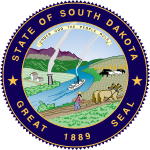Republican convention
In the lead-up to the Republican convention, which took place in Aberdeen on July 8, 1896, several candidates either announced their candidacies for Governor or were seen as likely candidates: [1] former Secretary of State Amund O. Ringsrud, Lieutenant Governor Charles N. Herreid, former State Representative Millard F. Greeley from Deuel County, [2] and F. G. Hale, a member of the South Dakota Board of Regents. [3] As the convention approached, Ringsrud emerged as the frontrunner, [4] and ultimately won the nomination. [5]
People's Party convention
After three straight elections in which the left-leaning vote in South Dakota was split, a fusion finally took place. The coalition was precipitated by the exodus of Free Silver Republicans from the Republican Party of South Dakota, led by U.S. Senator Richard F. Pettigrew. Pettigrew and the Silver Republicans joined forces with the Populist Party at its convention, [6] which started on July 15, 1896, in Huron. [7] In the months preceding the convention, there was much speculation about whether prominent businessman Andrew E. Lee would be the Populist nominee for Governor, [8] or whether another candidate—like F. M. Goodykoontz [9] or former territorial legislator H. B. Wynn [10] —would replace him. But when Pettigrew's forces joined with the Populists, Pettigrew began negotiating with Henry A. Loucks, a prominent leader in the Farmers' Alliance. The tentative agreement between Pettigrew and Loucks was to name Wynn as their nominee for Governor, and if this failed, to name Lee for Governor and Wynn for Treasurer. But Wynn's refusal to accept a position other than Governor, and Lee's refusal to accept any deal with Wynn, ultimately led the convention to nominate Lee for Governor. [11] Shortly after the convention, the Democratic Party endorsed the Populist slate of candidates, declining to hold its own convention. As a result, the People's Party was formed to contest the 1896 election. [6]
This page is based on this
Wikipedia article Text is available under the
CC BY-SA 4.0 license; additional terms may apply.
Images, videos and audio are available under their respective licenses.



